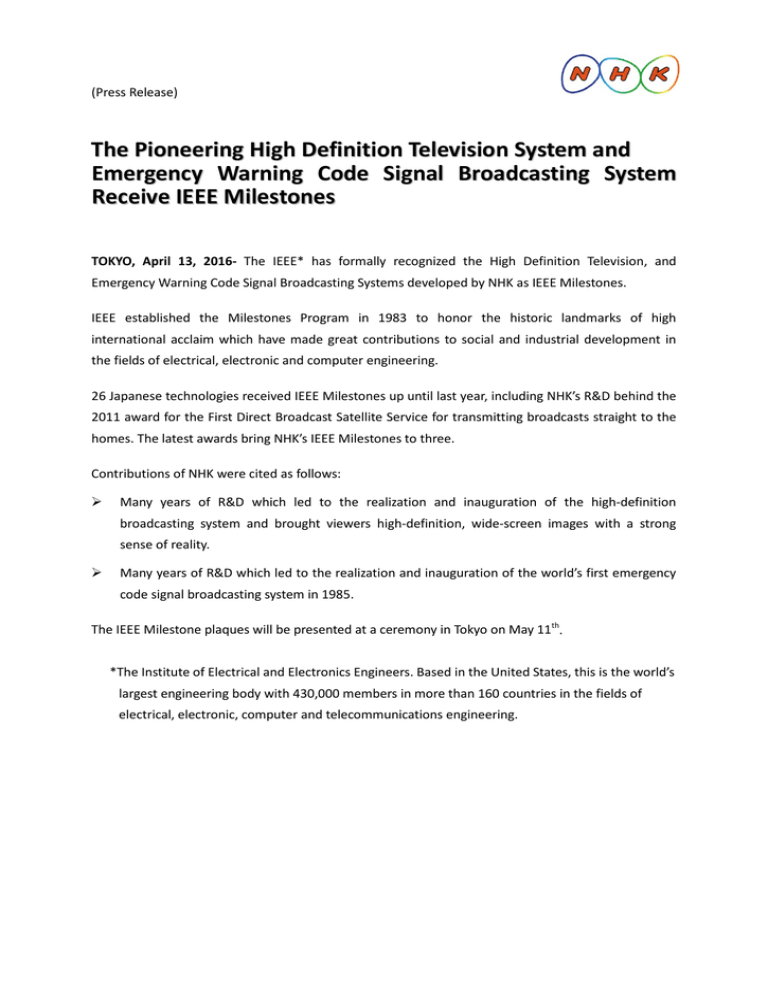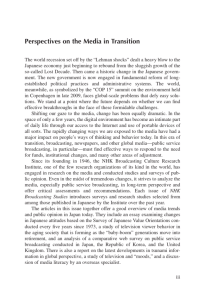The Pioneering High Definition Television System and Emergency
advertisement

(Press Release) The Pioneering High Definition Television System and Emergency Warning Code Signal Broadcasting System Receive IEEE Milestones TOKYO, April 13, 2016- The IEEE* has formally recognized the High Definition Television, and Emergency Warning Code Signal Broadcasting Systems developed by NHK as IEEE Milestones. IEEE established the Milestones Program in 1983 to honor the historic landmarks of high international acclaim which have made great contributions to social and industrial development in the fields of electrical, electronic and computer engineering. 26 Japanese technologies received IEEE Milestones up until last year, including NHK’s R&D behind the 2011 award for the First Direct Broadcast Satellite Service for transmitting broadcasts straight to the homes. The latest awards bring NHK’s IEEE Milestones to three. Contributions of NHK were cited as follows: Many years of R&D which led to the realization and inauguration of the high-definition broadcasting system and brought viewers high-definition, wide-screen images with a strong sense of reality. Many years of R&D which led to the realization and inauguration of the world’s first emergency code signal broadcasting system in 1985. The IEEE Milestone plaques will be presented at a ceremony in Tokyo on May 11th. *The Institute of Electrical and Electronics Engineers. Based in the United States, this is the world’s largest engineering body with 430,000 members in more than 160 countries in the fields of electrical, electronic, computer and telecommunications engineering. (Attachment) High Definition Television System NHK commenced basic research on high-quality television in 1964, engaging in wide-ranging studies from psychophysical experiments to system development. The basic technology was proven by the world’s first regular experimental broadcasting via satellite, which was commenced in 1989 with a high definition, 1,125 scanning lines on a 16:9 ratio screen. The 1,125 scanning line format was made the unified global standard in 2000 as high-definition television spread worldwide. Wide screen display with 1,125 scanning lines Testing the effects of viewing angle on the sense of reality Emergency Signal Code Broadcasting System NHK realized the emergency signal code broadcasting system, which turns on TV and radio sets automatically and conveys warning signals when a major earthquake, tsunami, or other disaster impends. The system has been incorporated to the global standards for both satellite and terrestrial broadcasting. The emergency signal broadcasting system continues in current use in support of disaster-related broadcasts. Meteorological Agency 1) Announcement of impending large earthquake 2) Tsunami Warning 3) Instruction from prefectural governor Prefectural Office Emergency Broadcast, Warning Signal Automatic Operation Activating Signal Broadcaster Transmitting Station (Reference) Major Milestones Japan Theme Dedicated Year TPC-1 Transpacific Cable System, 1964 2014 International Standardization of G3 Facsimile, 1980 2012 Development of Electronic Television, 1924-1941 2009 The First Word Processor for the Japanese Language, 1971-1978 2008 Development of VHS, a World Standard for Home Video Recording, 1976 2006 Pioneering Work on Electronic Calculators, 1964-1973 2005 Tokaido Shinkansen (Bullet Train), 1964 2000 Mount Fuji Radar System, 1964 2000 Overseas Theme Dedicated Year Country Invention of Stereo Sound Reproduction, 1931 2015 UK Birthplace of the Bar Code, 1948 2012 U.S.A Grumman Lunar Module, 1962-1972 2011 U.S.A Birthplace of the Internet, 1969 2009 U.S.A Compact Disc Audio Player, 1979 2009 Netherlands Volta's Electrical Battery Invention, 1799 1999 Italy Manufacture of Transistors, 1951 1989 U.S.A


